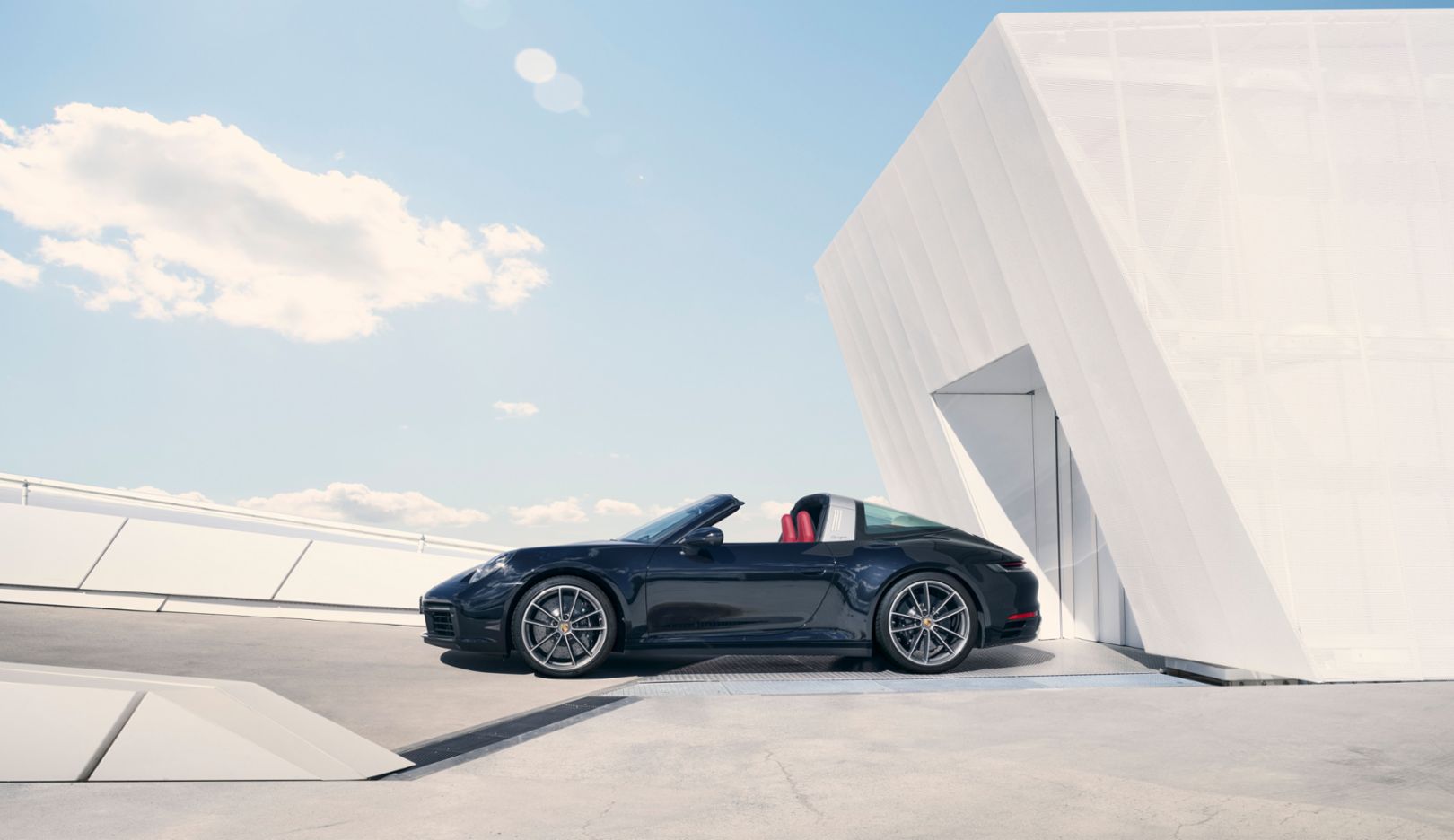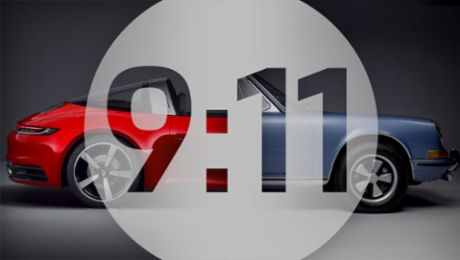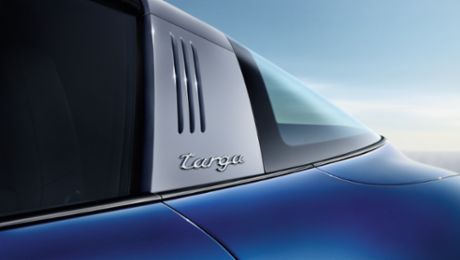The distinguishing feature of the Targa remains its innovative, fully automatic roof system and, just like the legendary original Targa model from 1965, it features a characteristic wide roll hoop, a movable roof section above the front seats and a wraparound rear window. The roof can be comfortably opened and closed in just 19 seconds.

It is powered by a six-cylinder, three-litre boxer engine with twin turbochargers: the 911 Targa 4 now delivers 283 kW / 385 PS* (horsepower) and, in combination with the optional Sport Chrono package, accelerates from zero to 100 km/h in just 4.2 seconds – one tenth faster than before.
The engine in the 911 Targa 4S boasts 331 kW / 450 PS* (horsepower) and reaches the 100 km/h mark in just 3.6 seconds under the same conditions – four tenths faster than its predecessor. Top speed of the 911 Targa 4 is 289 km/h (up two km/h), while the 4S peaks at 304 km/h (up three km/h).
Both sports cars are fitted with eight-speed dual-clutch transmission (PDK) and intelligent all-wheel drive Porsche Traction Management (PTM) as standard to deliver maximum driving pleasure.
Thanks to the enhanced optional Smartlift function, ground clearance can be programmed so that it is raised for everyday use. The list of options is supplemented by an extensive range from Porsche Tequipment and new personalisation options from Porsche Exclusive Manufaktur.
Porsche will further extend the combination of traditional style elements, timeless design and cutting-edge technology in a special edition of the 911 Targa, which will make its debut in June.
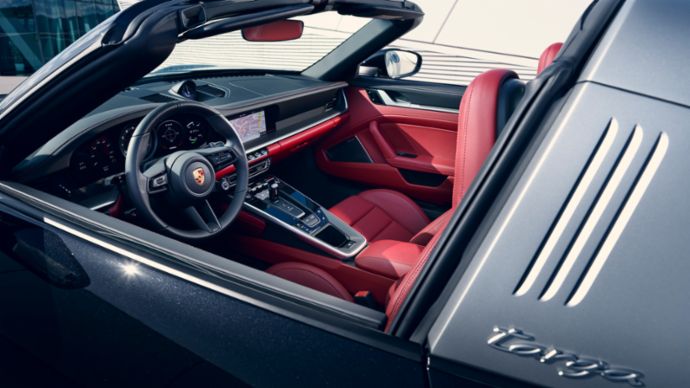
Efficient biturbo boxer engine
Like the 911 Carrera models, both 911 Targa variants benefit from the increase in power provided by the turbocharged three-litre six-cylinder boxer engines, resulting in performance and everyday usability.
The engine in the 911 Targa 4 produces 283 kW / 385 PS* (horsepower) at 6,500 rpm, which is 11 kW / 15 PS* (horsepower) more than its predecessor. Maximum torque of 450 Newton metres is delivered across a wide engine speed range of between 1,950 and 5,000 rpm. With 331 kW / 450 PS* (horsepower), the 911 Targa 4S delivers 22 kW / 30 PS* (horsepower) more output than its predecessor and generates maximum torque of 530 Nm (up 30 Nm) between 2,300 and 5,000 rpm.
Optimised all-wheel drive for better traction
The enhanced performance of the new all-wheel drive models goes hand-in-hand with further development of the front-axle drive.
The clutch and differential unit is water-cooled and has reinforced clutch discs for greater robustness and a higher load capacity.
The increased actuating torque at the clutch improves its adjustment accuracy and the function of the additional front-axle drive. Overall, the enhanced front-axle drive with PTM (Porsche Traction Management) contributes to even better traction in all road conditions.
Enhanced chassis for more comfort and safety
The electronically controlled variable damping system PASM (Porsche Active Suspension Management) is part of the standard equipment on the new 911 Targa models. This system automatically adjusts the damping characteristics in terms of driving comfort and handling to each driving situation and has two manually adjustable maps, Normal and Sport.
Porsche Torque Vectoring Plus (PTV Plus), which includes an electronic rear differential lock with fully variable torque distribution, is added as standard equipment for the Targa 4S and is available as an option on the Targa 4.
Like the other eighth generation Porsche 911 variants, the Targa models are also equipped with Porsche Wet mode as standard. Sensors fitted in the front wheel housings are capable of detecting water on the road surface and, if significant volumes of water are picked up, a signal in the cockpit provides a recommendation for the driver to manually switch to Wet mode. The drive responsiveness is then adapted to the conditions to guarantee maximum driving stability.
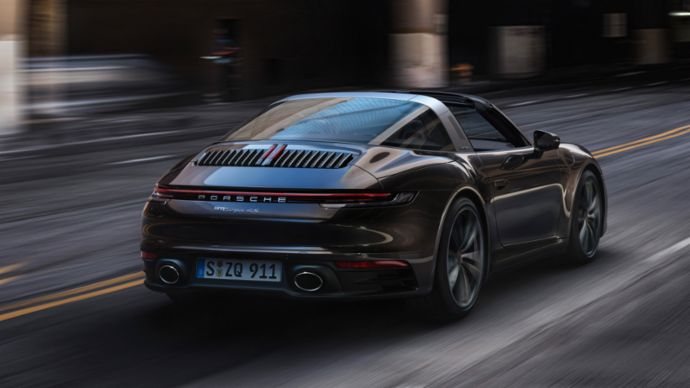
The driving dynamics setup for the 911 Targa 4 includes 235/40 ZR tyres on 19-inch alloy wheels on the front axle and 295/35 ZR tyres on 20-inch wheels on the rear axle.
As standard, the 4S model is fitted with 245/35 ZR tyres on its 20-inch front wheels and 305/30 ZR tyres on its 21-inch rears.
On the Targa 4, deceleration is taken care of on both axles by 330-millimetre brake discs with black four-piston monobloc fixed callipers.
The red-painted brake callipers on the Targa 4S have six pistons at the front axle, four at the rear while its discs measure 350 mm front and rear. The Porsche Ceramic Composite Brake (PCCB) can be ordered as an option.
Targa design with a modern interpretation
The exterior of the 911 Targa is characterised by the design elements of its 992 model generation.
Compared to its predecessors, its body features significantly more pronounced wheel housings at the front and, between its LED headlights, its bonnet has a distinctive recess evoking the design of the first 911 generations.
Its rear is dominated by its wider, variably extending rear spoiler and seamlessly integrated, elegant light bar. With the exception of the front and rear sections, the entire outer skin is made from aluminium.

The interior echoes the 911 Carrera models and is characterised by the clear and straight lines of its dashboard and its recessed instruments.
The 911 models from the 1970s provided the inspiration here. Alongside the central rev counter – very much a defining feature for Porsche – two thin, frameless freeform displays extend the information provided to the driver.
A compact switch unit with five buttons for direct access to important vehicle functions is located below the 10.9-inch centre screen of the Porsche Communication Management (PCM). The standard PCM features include online navigation as well as Porsche Connect Plus.
The model for a new class of sports cars since 1965
The 1965 911 Targa 2.0 was a trailblazer for a whole new type of car. Originally marketed as a "safety cabriolet with anti-roll bar", the Targa, with its detachable roof, soon established itself as an independent concept and indeed became a style icon.
Right through to the present day, Porsche has continued to combine two worlds in the 911 Targa: the advantages of open-top driving in a cabriolet combined with the everyday comfort and safety of a coupé.
World premiere on 9:11 Magazine web TV channel
For the first time the sports car manufacturer unveils the new 911 Targa to a global audience on its own web TV channel. Dr. Frank-Steffen Walliser, Vice President Model Lines 911 and 718, explains the car’s new features along with Porsche Brand Ambassadors, tennis star Maria Sharapova and racing driver Jörg Bergmeister on 911-magazine.porsche.com.
Australia
In addition to the worldwide standard specifications, Australian models of the 911 Targa and 911 Targa 4 will be additionally equipped with LED main headlights with Porsche Dynamic Light System Plus (PDLS Plus), windscreen with grey top tint, electrically folding exterior mirrors, automatically-dimming mirrors, metallic paint, Surround View, Lane Change Assist, Comfort Access, front seat heating, 14-way sports seats with memory package, digital radio and BOSE Surround Sound system.
The new 911 Targa models are available to order now, and will arrive in Australia from Q3 of 2020.
^ Prices are manufacturer’s recommended retail prices before statutory on-road and dealer delivery charges, which vary from State to State
* PS (PferdeStärke, German for horsepower) is the standard unit used in the European Union to measure the power output of a motor in ‘metric horsepower’
